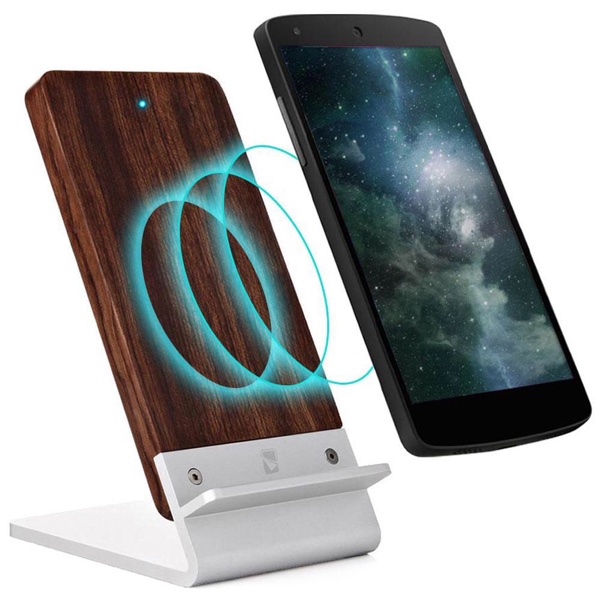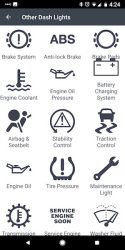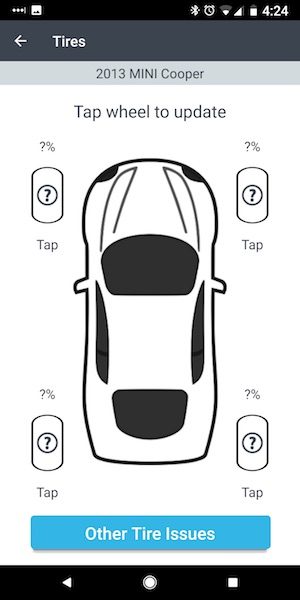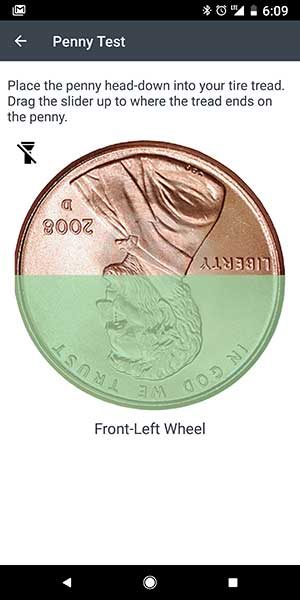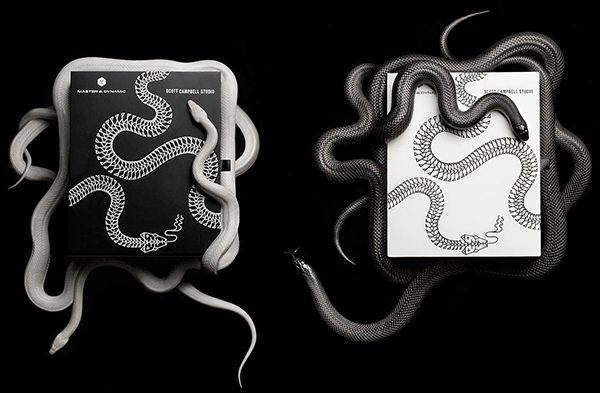Slowly but surely Qi charging is being integrated into more of our personal devices. With the iPhone 8 and X having Qi charging, more companies are looking to take advantage of the upswing in Qi charging technology. One of the easiest ways to take advantage of this charging method is charging stands. There are a lot of these stands on the market today, but I have noticed that there seems to be a lack of style in most of them. Cooper Cases has changed that with their introduction of the Cooper Ecostand Qi wireless charging stand. The Cooper stand is made of aluminum and rosewood, not boring plastic like a lot of current Qi charging stands. With a triple coil charge plate for a wider charging area and an ergonomic stand design (allowing you to comfortably read your device while it is charging), the Cooper Ecostand Qi wireless charging stand has style. At a price of $29.95 from the Cooper Case web site, you can afford to Qi charge in style.
FIXD car health sensor review

Have you ever had the check engine light on your car’s dash light up and wondered what it meant but didn’t know if you should call a mechanic right away? I’ve been having that same question lately with my MINI Cooper. Sometimes when I start the engine, I’ll see an icon of a car on a lift show up on my dashboard. The info in my manual about that light isn’t very detailed and my dealer is over 70 miles away, so I’ve been ignoring the light because it will sometimes go away for days at a time before lighting up again.
When I was asked If I would be interested in reviewing the FIXR OBD car sensor, I was happy to check it out with hopes that it would solve my dash light concerns. Let’s see if it has.
What is it?
FIXD is a small sensor that plugs into your vehicle’s OBD sensor and then pairs with your smartphone and an app to display information about check engine lights, maintenance requirements, and more.
Design and features
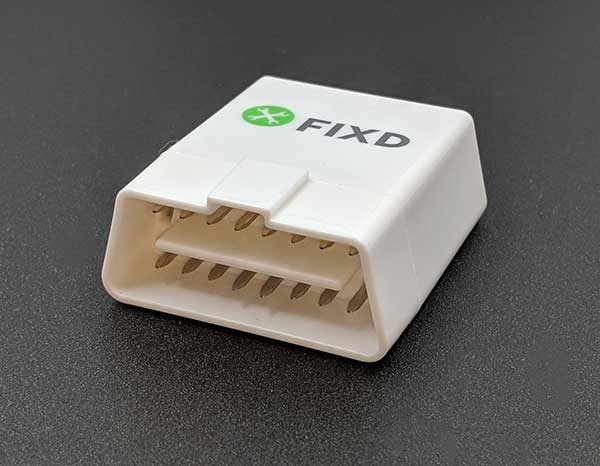
The FIXD is a small white plastic sensor with two rows of pins. This adapter plugs into the OBD-II port on your car which is usually located under the dash. The FIXD sensor is compatible with gas-powered cars that were manufactured after 1996. This adapter will not work with all-electric or diesel vehicles.
Installation and usage
To install and use FIXD, you have to download the iOS or Android app on your mobile device and then follow the prompts in the app that tell you to register and then plug in and connect to the sensor with your phone. FYI: the app requires that you create an account to use it which is kind of annoying considering every gadget we buy these days requires an account and password to be created just to use it.
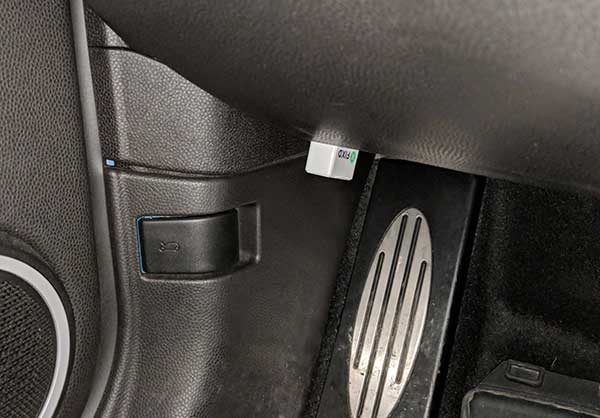
When prompted, you plug the FIXD sensor into the OBD-II port on your car. On my MINI Cooper, the port is under the dash near the driver’s side door.
Once plugged in, the app will search for the FIXD sensor and connect to it. This can take around 30 seconds and happens every time you launch the app. The first time you run the app, you are prompted to enter the mileage and then the app will report if there’s a check engine light on and is supposed to tell you what that light means. That’s actually the only light this product can help with. It can’t help you with other dash lights like TPMS, ABS, Airbag, Maintenance lights, Stability Control, etc which are only accessible through manufacturer-specific information. But there’s a screen in the app that shows other lights and what they might mean. That screen didn’t include the dash light that I have been seeing on my car.

The FIXD app is also supposed to alert you when it’s time for an oil change and other regular maintenance tasks.
The app has a screen where it looks like it will let you see the tire pressure in each tire. My MINI Cooper has built-in warnings when it detects if the pressure is low, but the FIXD app didn’t show any pressure info when I tapped the tires. It just prompted me to do the penny in the tire tread test so it could compute when I might need new tires. Disappointment #1.
I wasn’t interested in being reminded when to change my oil or when to get new tires. I already have reminders to schedule an oil change built into my car. I was only interested in figuring out what the light on my dash meant. Unfortunately, the light on my dash was NOT a check engine light, so the FIXD adapter was not able to help me. Bummer. Disappointment #2.

After some digging, I think I figured out that my problem may be due to my MINI’s battery which is the original battery that was installed in the 2013 model when I bought it.

I used the FIXD app to check the resting voltage of the battery and it showed 11.6 V which I learned is low considering I’d just driven for about 20 minutes before checking it. Funny thing is that the app didn’t warn me that my battery might be bad with that reading. Disappointment #3.
What I like
- Easy to install
- Maintenance reminders (if you need them)
- Displays resting battery voltage test
- Supposed to tell you what the check engine light means
What needs to be improved
- Slow to connect to the sensor
- Didn’t warn me when my battery’s resting voltage was low
- Only reports check engine light issues and not other dash lights
- Have to create an account to use it
Final thoughts
The FIXD sensor seems like it would be a cool car gadget, but it doesn’t do much that’s useful until you actually have a check engine light come on. I’ve been using this sensor in my car for weeks and haven’t had a check engine light and the FIXD sensor can’t tell me what the other light on my dash means. That and the fact that the sensor can’t tell me my tire pressures or warn me that my battery is low doesn’t really inspire confidence that it will even be able to help me in the event that the check engine light on my dash actually does come on.
I can’t say that the FIXD sensor is a complete waste of money because I am unable to test that its main feature even works. But from what I was able to test, I’m not impressed and can’t recommend buying one.
Price: $59.99
Where to buy: Amazon
Source: The sample for this review was provided by FIXD.
Your wallet full as a fridge? Switch to the Ridge minimalist wallet
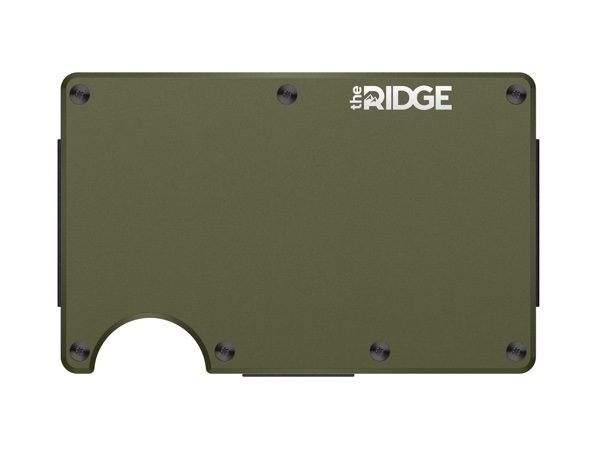
Although I am not always on the lookout for a new wallet, When I see something that looks interesting I like to give it a mention. The Ridge wallet has recently caught my eye not only for the design but also the different material models they have. The basic wallet design is two outer plates covering an inner elastic band that holds up to 12 cards. All the wallets offer RFID (Radio Frequency Identification) protection and come with a money clip attached to the rear or an elastic cash strap option. The Ridge comes in carbon fiber, titanium, aluminum or polycarbonate in various colors. Another nice feature of The Ridge wallets is the ability to get replacement parts from their website, allowing you to keep your wallet in tip-top condition. The Ridge wallet starts at $45 for the polycarbonate model and runs up to $115 for the carbon fiber model. You can buy and get further information about The Ridge wallet at The Ridge website.
Note from Julie: We actually reviewed the Ridge wallet a few years ago.
Master & Dynamic has tattoo-inspired headphones designed by Scott Campbell
Master & Dynamic’s gorgeous line of headphones continue to be reworked by famed designers—this time by bicoastal tattoo artist, Scott Campbell. Campbell has woven his fascination with snakes into the design of M&D’s MW60 Wireless and MH40 headphones—each adorned with hand-painted art by Campbell. The black on white or white on black reptilian motif gives the phones a distinctive, if slightly menacing look right down to a Campbell quote inside the ear cups, “The smartest things I ever did were stupid things for love.”
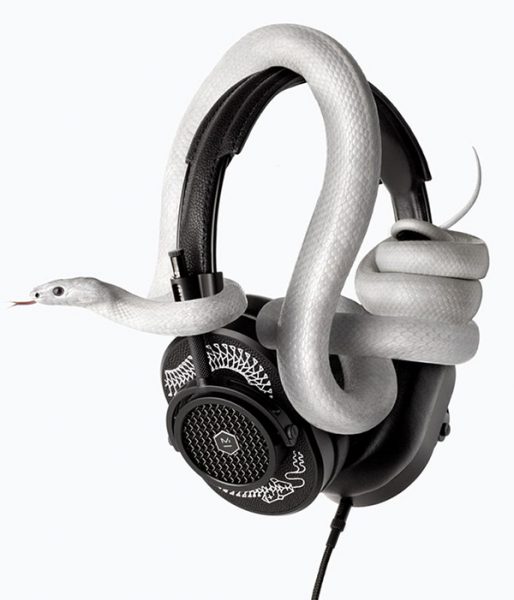 “I have always thought Scott’s work was quite genius. When I met Scott in Hong Kong, I learned we shared a willingness to take risks in pursuit of our dreams, even if it means sometimes making mistakes. Through this collaboration Scott can share his art more broadly with his fans, whether or not they are collectors of his fine art or tattoo enthusiasts,” said Master & Dynamic’s Founder and CEO Jonathan Levine.
“I have always thought Scott’s work was quite genius. When I met Scott in Hong Kong, I learned we shared a willingness to take risks in pursuit of our dreams, even if it means sometimes making mistakes. Through this collaboration Scott can share his art more broadly with his fans, whether or not they are collectors of his fine art or tattoo enthusiasts,” said Master & Dynamic’s Founder and CEO Jonathan Levine.
The Scott Campbell inspired MW60 Wireless and MH40 are identical in design and price to the original M&D iconic headphones. The MH40 and MW60 are available now and sell for $399 and $549 respectively. Visit www.masterdynamic.com for more info.
DROCON MJX Bugs 3 drone review
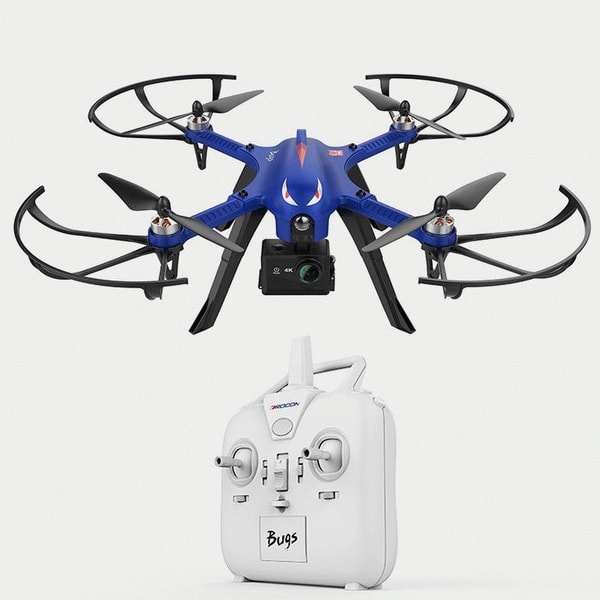
If you have a HERO4 (or clone) then you may want to take some shots from the sky. The MJX Drocon Bugs 3 is an low-priced entry level hobby-grade drone that comes standard with a HERO4 camera mount and features great speed, range and battery capacity. Read on to see what I think!
Bugs 3 is a drone that has enough power to proficiently carry a HERO4 shaped action camera. The drone features 2.4 GHz two way communication for security and control, brushless motors for speed, power and efficiency, a 1800 mAh battery for extended flight time, and a body design that makes upgrading or replacing parts an easy to accomplish task. While the drone doesn’t have flight by GPS, altitude hold mode, one key take off landing, or headless mode, it does have gyro stability and can be flown with the speed and agility of a racer. In fact, with the addition of a FPV camera this could also be an entry level racer drone. I believe it would sell well if it were sold with the FPV camera instead of the action camera mount. (The FPV can be purchased from here.)
Throughout the review you may see the manufacturer as Drocon or MJX. I believe that Drocon is marketing the Bugs 3 drone in Europe and the US but the drone is actually manufactured by MJX R/C in China.
What’s in the box?

MJX BUGS 3
Battery 7.4V 1800mAh 25C LiPo
2.4GHz Controller (power from 4 × AA is purchased separately)
Camera mount
4 × carrying screws
4 × spare rotor
4 × rotor protection
4 × landing mounts
Charger
A set of spacers (to compensate for gaps when installing cameras)
Set of branded stickers
Tool (screwdriver + key for unscrewing the screws)
User Manual
Design and features
Prerequisites
There are a couple of prerequisites for flying this drone:
Because of the weight of the drone is above the minimum weight requirement of 0.55 lbs. or 8.8oz, it must be registered with the FAA at the following weblink: https://faadronezone.faa.gov/#/
This should definitely not be the first drone you pilot. Even though the parts on it are readily replaceable and the controls are relatively easy to use this is a big powerful drone that can easily reach high altitudes and rapid speeds. Don’t get this caught in a tree on your first flight.
Unboxing

One of the first things you notice is how big the drone is. The unit has a 31 cm wheelbase. However, the box is only designed to hold the unassembled unit and the protective packaging in the box is a cast styrofoam which is likely to break after repeated use. If you would like a storage case for the drone you’ll need to create your own.

Assembly
putting the drone together is straight forward. Installing the correct props on each motor is a breeze (see what I did there) since they are each labeled with a letter corresponding to the pitch (A brief primer: The props on a quadcopter each rotate in a direction opposite from the adjacent motor. The pitch of each prop is designed so that lift is provided when the motor turns correctly.) 
The drone comes with these little feet at the bottom of each prop motor. But the screws need to be removed if the rotor guards are going to be installed. Below the screws that require removal are shown.
 The components all screw into the nylon frame. the frame has been designed with adequate reinforcement around the screws. There are also some holes along the bottom of the body chassis to install the extended legs that provide the clearance required by the camera mount. The frame is pliable rather than rigid, as it would be if it were carbon fiber. But, the frame is also very affordable to replace, costing less than $10 at some on-line retailers.
The components all screw into the nylon frame. the frame has been designed with adequate reinforcement around the screws. There are also some holes along the bottom of the body chassis to install the extended legs that provide the clearance required by the camera mount. The frame is pliable rather than rigid, as it would be if it were carbon fiber. But, the frame is also very affordable to replace, costing less than $10 at some on-line retailers.
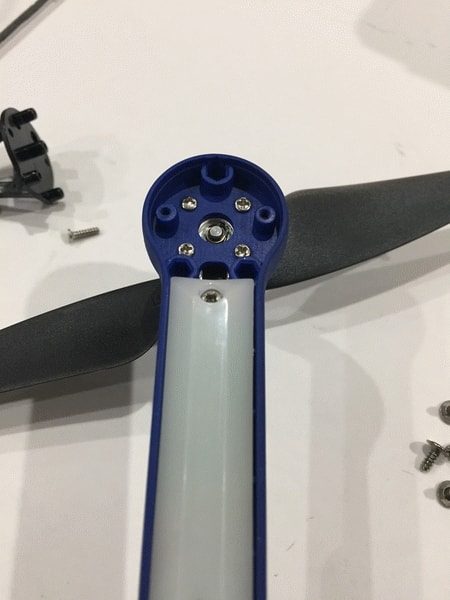
Also, the canopy is removable without tools.
Installing and removing jumpers can hypothetically be done in the field without tools. With the canopy removed you can see that the motherboard has separate electronic speed controls for each motor (each sealed). The motors are soldered to the Flight control board under some pretty heavy glue, but the LEDs are all connected with molex and can be easily removed if desired. There’s also a molex for the FPV camera presumably to trigger a photo or video capture.
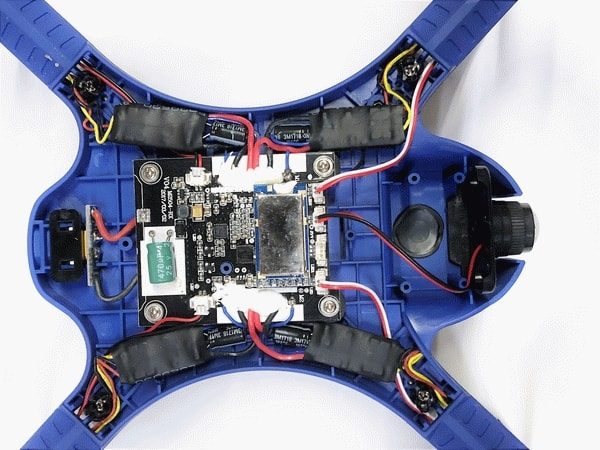
Design
This is the first brushless motor drone manufactured by MJX. They have designed their own flight control board and speed controllers to work with the MT1806 1800KV motors. These motors provide 230g of thrust as stated by the manufacturer but Halfchrome put this on a test rig and determined the combined thrust at 1090g, which is 272g each motor. Either way, the drone has some serious lift. If the FPV is installed, adding 40g, the drone still has a T/W ratio of 1.8 if you go by the 230g figure or 2.1 if you use Halfchrome’s measurement. These performance figures should allow the drone to operate nicely, even in heavy wind. Well, there is a bit of a catch to my last claim. The camera mount isn’t on a full gimbal, so when the drone tilts in a pitch or roll to correct location the camera tilts too. This type of performance is typical for FPV but should be avoided during aerial photography.
The camera is supported by a hinged mount that operates in only one direction attached below the battery cage. The topside of the hinge is designed with a vibration isolation box consisting of a plate surrounded by silicone ribs fit into a small box. It seems to work well in limiting the high frequency jitter of the captured video.
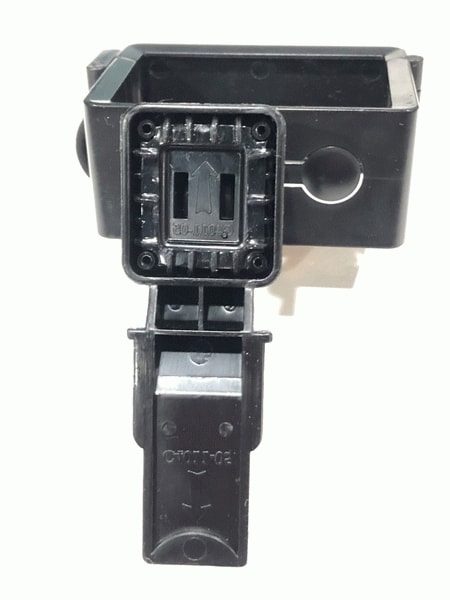 The Whole camera mount slides into a groove below the battery and is help in place by a rotating tab. This is useful so that the camera can be mounted and dismounted from the drone easily, but concerns me that the rotating tab could shake free mid flight. The camera fits inside of a frame that surrounds the outside of the camera frame. If the camera doesn’t have very similar dimensions to a GoPro it may not fit. the surround has a tab to allow the top button to be pressed but conceals the rest of the camera’s sides.
The Whole camera mount slides into a groove below the battery and is help in place by a rotating tab. This is useful so that the camera can be mounted and dismounted from the drone easily, but concerns me that the rotating tab could shake free mid flight. The camera fits inside of a frame that surrounds the outside of the camera frame. If the camera doesn’t have very similar dimensions to a GoPro it may not fit. the surround has a tab to allow the top button to be pressed but conceals the rest of the camera’s sides.
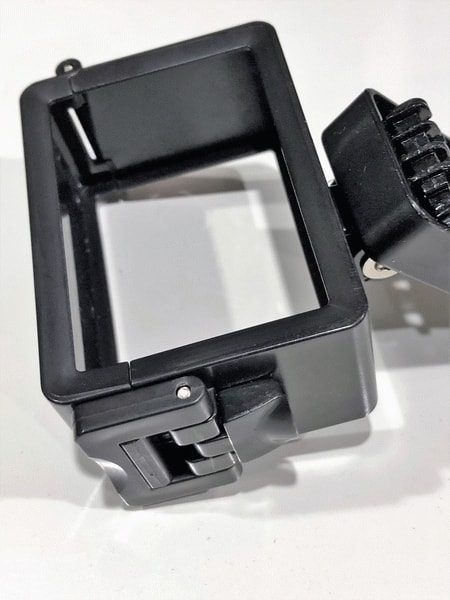
Operation
The Bugs 3 comes with a 7.4V 1800mAh 25C Li Poly battery that is a proprietary design with standard features. The battery connects to the drone with an XT30 connector and has close to standard dimensions, but the battery comes with a balance port that works quite well with the built in charger and has a plastic enclosure around the main body fits perfectly into the battery bay. Without the camera and tall landing legs, and with an unconditioned battery on a cold day, I got 15 minutes of flight. With the camera and tall gear installed I got about 11 minutes.
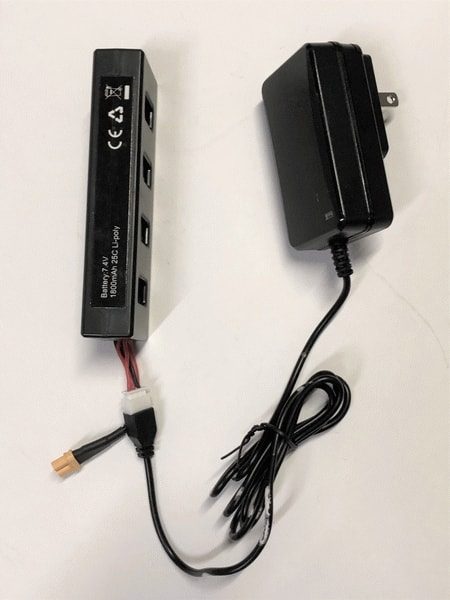
The claimed range of the controller is 300-500 meters which is probably farther than it may be legally operated (hobbyists must fly within visual line of sight). There is a low signal warning that the controller will emit if the signal strength diminishes. I didn’t have a chance to fly it real far not did I have a way to judge exactly how far I did fly it. MJX gives this disclaimer in their literature, “Just make sure you can find your drone in the sky and distinguish the right direction to call it back.”
Performance
I’ve recorded a couple of videos to convey the abilities of this drone to act as a platform for aerial photography and also act as a racer. The videos were recorded with a point and shoot strapped to my head. I didn’t have the angle set right so the drone goes out of frame, but it is just above the top of the frame in the smaller video to the left.
What I like
- Affordably priced for a brushless drone
- Good for aerial photography and intro level racing (no acro mode)
- Long lasting battery
- Well calibrated gyros
- Inexpensive replacement parts
- Easy to modify
What needs to be improved
- Fixed gimbal
- Tall gear may get in camera view
- No acro mode and no betaflight
Final thoughts
The Bugs3 lands somewhere between a low budget camera drone or intro racer, and a high priced aerial drone or racer. I prefer to focus on the advantages that this unit has above its lower priced cousins. It’s really enjoyable to fly and on a calm day and in open spaces it can provide a great picture.
Price: $89.99
Where to buy: Amazon
Source: The sample for this review was provided by Drocon.

